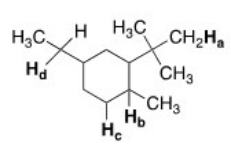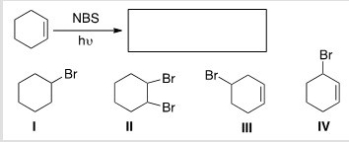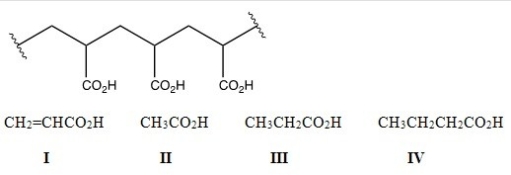A) III< I < II
B) I < II < III
C) III < II < I
D) I < III < II
Correct Answer

verified
Correct Answer
verified
Multiple Choice
Which of the following compounds contain secondary (2°) radical carbons? 
A) Only I
B) Only II
C) Only III
D) Only II and IV
Correct Answer

verified
Correct Answer
verified
Multiple Choice
Which of the following alkenes undergoes allylic bromination to form a single monobrominated product? 
A) I
B) II
C) III
D) IV
Correct Answer

verified
Correct Answer
verified
Multiple Choice
Which of the following is a radical scavenger?
A) O3
B) O2
C) Vitamin C
D) CO2
Correct Answer

verified
Correct Answer
verified
Multiple Choice
Which of the labeled hydrogens is most easily abstracted in a free radical bromination reaction? 
A) Ha
B) Hb
C) Hc
D) Hd
Correct Answer

verified
Correct Answer
verified
Multiple Choice
How many monochlorination products can be formed from the reaction of (CH3) 3CH with Cl2 and hn?
A) 1
B) 2
C) 3
D) 4
Correct Answer

verified
Correct Answer
verified
Multiple Choice
Which steps are the rate-determining step in the mechanism of radical halogenation?
A) Initiation
B) Propagation
C) Termination
D) Initiation and propagation
Correct Answer

verified
Correct Answer
verified
Multiple Choice
Which of the following statements about radical reactions is not true?
A) Light or heat provides the energy needed for homolytic bond cleavage to form radicals.
B) Breaking the weak O-O bond of peroxides initiates radical reactions.
C) The diradical O2 removes radicals from a reaction mixture.
D) Radicals rearrange.
Correct Answer

verified
Correct Answer
verified
Multiple Choice
Which of the following statements about bromination is true?
A) The rate-determining step in bromination is exothermic.
B) Both radicals are formed.
C) A mixture of products results.
D) A single radical halogenation product predominates.
Correct Answer

verified
Correct Answer
verified
Multiple Choice
Select the route that would most likely produce the desired results from the given starting material.  I.(1) H2SO4 and heat; (2) HBr II.(1) KOH in ethanol; (2) HBr
III) (1) H2SO4 and heat; (2) HBr + peroxides
IV) (1) potassium tert-butoxide in tert-butanol; (2) HBr + peroxides
I.(1) H2SO4 and heat; (2) HBr II.(1) KOH in ethanol; (2) HBr
III) (1) H2SO4 and heat; (2) HBr + peroxides
IV) (1) potassium tert-butoxide in tert-butanol; (2) HBr + peroxides
A) I
B) II
C) III
D) IV
Correct Answer

verified
Correct Answer
verified
Multiple Choice
A possible reaction of ethane with chlorine is shown below. ![A possible reaction of ethane with chlorine is shown below. This reaction could conceivably occur by the following chain mechanisms [1],[2],and [3].The chain propagating step(s) is (are) ________. A) Only [1] and [2] B) Only [2] and [3] C) Only [1] and [3] D) Only [3]](https://d2lvgg3v3hfg70.cloudfront.net/TB7814/11eac680_9c00_24c0_a448_9169511b4f9c_TB7814_00.jpg) This reaction could conceivably occur by the following chain mechanisms [1],[2],and [3].The chain propagating step(s) is (are) ________.
This reaction could conceivably occur by the following chain mechanisms [1],[2],and [3].The chain propagating step(s) is (are) ________. ![A possible reaction of ethane with chlorine is shown below. This reaction could conceivably occur by the following chain mechanisms [1],[2],and [3].The chain propagating step(s) is (are) ________. A) Only [1] and [2] B) Only [2] and [3] C) Only [1] and [3] D) Only [3]](https://d2lvgg3v3hfg70.cloudfront.net/TB7814/11eac680_9c00_24c1_a448_f5230a6e97b4_TB7814_00.jpg)
A) Only [1] and [2]
B) Only [2] and [3]
C) Only [1] and [3]
D) Only [3]
Correct Answer

verified
Correct Answer
verified
Multiple Choice
Which of the following statements about radicals and radical reactions is not true?
A) Most radicals are unstable.
B) A radical contains an atom that has an octet of electrons.
C) Half-headed arrows are used to show the movement of lone electrons.
D) A radical is formed by homolysis of a covalent bond.
Correct Answer

verified
Correct Answer
verified
Multiple Choice
Which of the indicated hydrogens is most readily abstracted in a free radical halogenation reaction? 
A) I
B) II
C) III
D) IV
Correct Answer

verified
Correct Answer
verified
Multiple Choice
Which of the following statements about radicals is true?
A) Cleavage of a stronger bond forms the more stable radical.
B) The stability of a radical increases as the number of alkyl groups bonded to the radical carbon decreases.
C) The higher the bond dissociation energy for a C-H bond,the more stable the resulting carbon radical.
D) Less stable radicals generally do not rearrange to more stable radicals.
Correct Answer

verified
Correct Answer
verified
Multiple Choice
Which of the following statements about the propagation steps in the chlorination of ethane is true?
A) Radical chlorination consists of two propagation steps.
B) The energy diagram for the propagation steps has three energy barriers.
C) The first of the propagation steps is rate-determining because its transition state is at lower energy.
D) The second of the propagation steps is rate-determining because its transition state is at higher energy.
Correct Answer

verified
Correct Answer
verified
Multiple Choice
Rank the following radicals in order of decreasing stability,putting the most stable first. 
A) II > IV > III > I
B) III > II > IV > I
C) IV > III > II > I
D) IV > III > I > II
Correct Answer

verified
Correct Answer
verified
Multiple Choice
What is the product of the following reaction? 
A) I
B) II
C) III
D) IV
Correct Answer

verified
Correct Answer
verified
Multiple Choice
Which of the following statements about chlorination is true?
A) The rate-determining step in chlorination is endothermic.
B) The transition state resembles the product.
C) The more stable radical is formed faster.
D) A mixture of products results.
Correct Answer

verified
Correct Answer
verified
Multiple Choice
Which of the following statements about carbon radicals is not true?
A) Carbon radicals are classified as primary,secondary,tertiary,or quaternary.
B) A carbon radical is sp2 hybridized.
C) The geometry of a carbon radical is trigonal planar.
D) The unhybridized p orbital in a carbon radical contains the unpaired electron.
Correct Answer

verified
Correct Answer
verified
Multiple Choice
Identify the monomer used to make the following polymer. 
A) I
B) II
C) III
D) IV
Correct Answer

verified
Correct Answer
verified
Showing 21 - 40 of 51
Related Exams